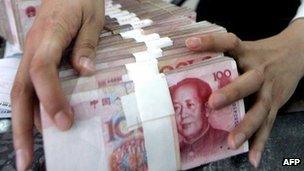China's interest rate cut indicates financial reforms
- Published

China has been trying to loosen its grip on the tightly controlled financial sector
With many of China's policy decisions, it is not the headline but the little details that reveal the real picture.
On Thursday, China's central bank, the People's Bank of China, cut its key interest rates for the first time since 2008.
There had been much speculation about such a move, the latest in a series of measures taken by Beijing to sustain growth.
However, it is the announcement alongside the rate cut that has thrown a light on the direction that China's policymakers are looking to take in the long term.
For the first time, the central bank has given banks flexibility to decide the interest rates they want to offer to consumers, within a stipulated range.
This means the banks will be able to offer higher interest rates to savers and lower rates to borrowers.
"The move is an important step towards 'interest rate liberalisation', which we have long argued is China's most urgent and also feasible reform," Barclays Capital analysts Jian Chang, Yiping Huang and Lingxiu Yang said in a note.
'Maximum returns'
This is not the first time that China has tried to use bank lending to spur growth.
It took similar measures after the global financial crisis, when banks lent record sums of money to ensure that the economy maintained a high rate of growth.
While the economy grew at a robust pace, the stimulus measures were highly criticised, and brought with them issues that threatened to derail the very growth they were supposed to sustain.
High liquidity led to rising property prices, fanning fears of asset bubbles and bad loans.
There were also concerns that a lot of the money was invested in sectors that did not have an impact on the real economy.
"There is strong evidence to suggest that there has been over-investment in assets and not enough focus on return on that investment," Stephen Davies of Javelin Wealth Management told the BBC.
Analysts say the flexibility in interest rates may help to counter the problem.
They say that as banks offer higher rates to savers and lower ones to borrowers, their profit margins may be squeezed, meaning they are likely to be more careful about who they lend to.
"This implies that resources get allocated to the projects that give maximum returns," says Arjuna Mahendran of HSBC Private Bank.
'Universe of opportunities'
China's growth over the years has been fuelled by the success of its export sector and by a rise in investment. However, both those sectors are facing a slowdown in their pace of growth.
Exports have been hurt, not least by a slowing demand from two of the biggest markets, the US and Europe.
Meanwhile, the growth in investment has also slowed and, according to some analysts, might weaken further.
"They pushed growth as far as they could and it was a boom that was unsustainable - and now we are actually seeing what unsustainable looks like," says Patrick Chovanec of Tsinghua University in Beijing.
"The investments will continue to be there but growth rates will moderate or even turn negative," he adds.
As a result, China has been trying to boost domestic consumption to rebalance its growth. Analysts say the flexibility in interest rates may help it achieve that.
They explain that the move will not only allow banks to give higher rates on savings, but will also see them offer a wide range of investment products which could help increase consumers' earning potential.
"When you give them those options it stimulates consumption as they are getting better returns on their investments and feel more comfortable in spending," says Mr Mahendran.
"It throws open a whole new universe of opportunities for the savers."
Stimulus v reform
China's economy grew at an annual rate of 8.1% in the first quarter, the slowest pace in almost three years.
As a result, there have been calls for Beijing to announce stimulus measures to boost domestic consumption.
However, analysts say that instead of injecting money into the economy, policymakers will be better off introducing further financial reforms.
"You don't need to fight the adjustment that is taking place, but facilitate it," says Tsinghua University's Mr Chovanec.
To China's credit, it has realised the importance of the issue and has introduced some changes in the financial sector.
Earlier this year, it widened the range in which the yuan is allowed to trade against the US dollar to 1.0% on either side of a daily rate set by the central bank. The previous limit was 0.5%.
The last time it made such a move was in 2007.
Analysts say that more financial reforms are likely to be introduced in the medium term.
"It is absolutely critical for the next level of growth to kick in - they don't really have a choice," says Mr Mahendran.